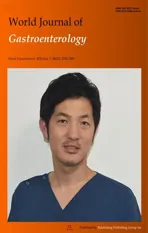Acupuncture and moxibustion for treatment of Crohn’s disease: A brief review
2022-12-06JingXieYanHuangHuanGanWuJingLi
Jing Xie,Yan Huang,Huan-Gan Wu,Jing Li
Abstract Crohn’s disease (CD) is a kind of intestinal inflammatory disease that can affect any part of the gastrointestinal tract and the incidence rate of CD is gradually increasing worldwide. Acupuncture and moxibustion have unique curative effects on gastrointestinal diseases and can be new options for the treatment of CD.
Key Words: Crohn’s disease; Acupuncture; Moxibustion; Treatment; Review
TO THE EDITOR
Crohn’s disease (CD) can affect any part of the gastrointestinal tract, especially the terminal ileum and the ascending colon, and is collectively known as inflammatory bowel disease (IBD) with ulcerative colitis. The main symptoms include abdominal pain, diarrhea, fistula, intestinal obstruction, fever,emaciation, and nutritional disorders. In the past three decades, the incidence rate of CD has gradually increased worldwide at an annual growth rate between 4%-15%, which warrants our attention[1].Currently, biological therapy is the preferred treatment for CD, and the commonly used biological agents such as infliximab and adalimumab have brought significant benefits to the patients. With multiple biological agents at their disposal, clinicians can, according to different symptoms, choose drugs with different anti-inflammatory mechanisms. However, despite the undisputed efficacy of these agents, a significant proportion of patients fail to receive effective treatments. For example, many patients do not respond to induction therapy or lose the response after initial improvements. As traditional Chinese medicine therapies, acupuncture and moxibustion have a long history in treating gastrointestinal diseases and significant advantages against symptoms such as abdominal pain,diarrhea, fatigue, and anorexia. Therefore, we summarize articles about clinical acupuncture and moxibustion treatment for CD to explore their unique advantages.
Using keywords such as acupuncture, CD, and clinical trials, we searched PubMed for clinical trials of acupuncture and moxibustion in the treatment of CD up to February 28, 2020, and found four articles that met the criteria. The four articles that we found and retrieved showed that acupuncture and moxibustion had curative effects on CD. Jooset al’s randomized controlled trial confirmed that after 4 wk of treatment, the CD activity index (CDAI) of the acupuncture group showed a significantly larger (P= 0.003) decrease (from 250 ± 51 to 163 ± 56) than that of the groups without acupuncture (from 220 ±42 to 181 ± 46)[2]. Baoet al’s 12-wk trial with the treatment group undergoing herb-partitioned moxibustion combined with acupuncture (HMA) and the control group receiving wheat bran partitioned moxibustion combined with superficial acupuncture showed a significantly higher (P=0.000) total treatment efficacy of the treatment group at 83.72% compared to 40.48% of the control group and a significantly lower (P= 0.000) CDAI in the treatment group than that of the control group[3]. Both clinical trials demonstrated that acupuncture combined with moxibustion significantly reduced the CDAI in the patients and significantly improved their quality of life. Shanget al[4] conducted a clinical trial with one group receiving HMA and the other group treated with mesalazine (MESA). After 12 wk of treatment, the expression ofZO-1mRNA in the HMA group was significantly improved compared with the MESA group (2378.17 ± 308.77vs2200.56 ± 281.88;P= 0.023), confirming that HMA can repair the intestinal epithelial barrier by up-regulating the expression of tight junction protein and its mRNA,thus reducing the intestinal inflammatory response in CD patients. Hortaet al[5] investigated whether electroacupuncture (EAc) therapy could relieve fatigue in patients with IBD by allocating 52 patients into the EAc, sham EAc (ShEAc), and waitlist (WL) groups. Evaluation with the IBD-validated Functional Assessment of Chronic Illness Therapy-Fatigue Scale showed reduced fatigue scores in patients of the EAc and ShEAc groups after 8 wk of treatment and significantly better curative effects in the two groups than that in the WL group.
According to these four clinical trials, acupuncture treatment tends to attenuate symptoms such as abdominal pain, diarrhea, and fatigue in patients with CD. Therefore, acupuncture and moxibustion therapy may potentially improve the physical and mental health of CD patients. Unfortunately, clinical trials of acupuncture for CD with relatively long-term observation and a large sample are still lacking.Except those conducted by Chinese researchers, there are few studies on treating CD with acupuncture,and more evidence is required to support the application of acupuncture and moxibustion therapies in treating CD and verify their potential benefits.
FOOTNOTES
Author contributions:Xie J wrote the manuscript; Yan H, Wu HG, and Li J edited the manuscript.
Supported bythe National Nature Science Foundation of China, No. 81774405 and No. 81873372.
Conflict-of-interest statement:All the authors report no relevant conflicts of interest for this article.
Open-Access:This article is an open-access article that was selected by an in-house editor and fully peer-reviewed by external reviewers. It is distributed in accordance with the Creative Commons Attribution NonCommercial (CC BYNC 4.0) license, which permits others to distribute, remix, adapt, build upon this work non-commercially, and license their derivative works on different terms, provided the original work is properly cited and the use is noncommercial. See: https://creativecommons.org/Licenses/by-nc/4.0/
Country/Territory of origin:China
ORCID number:Jing Xie 0000-0001-8982-5452; Yan Huang 0000-0002-5588-0274; Huan-Gan Wu 0000-0003-0563-1560;Jing Li 0000-0001-9388-5036.
S-Editor:Wang JJ
L-Editor:Wang TQ
P-Editor:Wang JJ
杂志排行
World Journal of Gastroenterology的其它文章
- Correction to “Gut microbiota dysbiosis in Chinese children with type 1 diabetes mellitus: An observational study”
- Correlation of molecular alterations with pathological features in hepatocellular carcinoma: Literature review and experience of an Italian center
- Mapping the global research landscape on nutrition and the gut microbiota: Visualization and bibliometric analysis
- Upregulated adenosine 2A receptor accelerates post-infectious irritable bowel syndrome by promoting CD4+ T cells’ T helper 17 polarization
- Fecal gene detection based on next generation sequencing for colorectal cancer diagnosis
- Incretin based therapy and pancreatic cancer: Realising the reality
